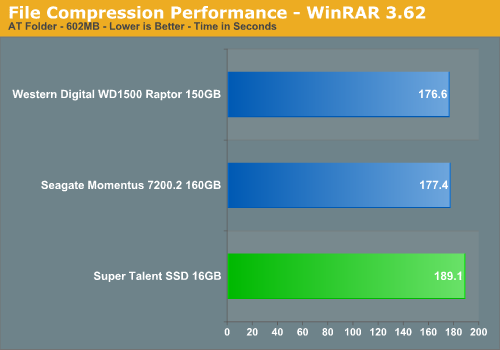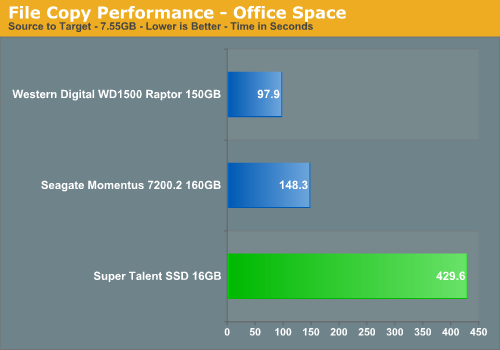Super Talent SSD: 16GB of Solid State Goodness
by Gary Key on May 7, 2007 4:00 AM EST- Posted in
- Storage
Actual Application Times - Multimedia and File Manipulation
The following tests require a fast CPU and excellent write performance of the disk drive. Our Super Talent drive will probably never run video/audio encoding applications in its target market so our tests are only meaningful for indicating the write performance of the drive in write heavy applications. These results and any conclusions about the performance of the drive need to be tempered with the commercial/industrial market this drive is designed to operate in. Again, we fully expect the new consumer SSD drives from Samsung and SanDisk to be competitive in these tests considering their improved write speeds.
Nero Recode
Our encoding test is quite easy - we take our original Office Space DVD and use AnyDVD Ripper to copy the full DVD to the hard drive without compression, thus providing an almost exact duplicate of the DVD. We then fire up Nero Recode 2, select our Office Space copy on the hard drive, and perform a shrink operation to allow the entire movie along with extras to fit on a single 4.5GB DVD disc. We leave all options on their defaults except we turn off the advanced analysis option. The scores reported include the full encoding process and are represented in seconds, with lower numbers indicating better performance.

This test is dependent on CPU performance and the write performance of the drive. As in our PCMark05 tests, the write performance of the Super Talent drive does not match that of our other test drives and is a little over four times slower than our Raptor drive, but it did finish the test without any issues.
WinRAR 3.62
Our WinRAR test measures the time it takes to compress our test folder that contains 444 files, 10 folders, and 602MB of data. This is the same test folder utilized in our IPEAK test suite. While the benchmark is CPU intensive for the compression tests it still requires a fast storage system to keep pace with the CPU. A drive that offers excellent write performance can make a slight difference in this benchmark.

This test relies much more on the CPU and burst rates of the storage system. Even handicapped with 25 MB/sec write speed, the Super Talent drive is only about 7% slower than the Raptor.
File Copy Performance
Our first file copy test measures the time it takes to transfer our test folder that contains 29 files, 1 folder, and has 7.55GB of data from our source drive to the target test drive. This benchmark is disk write intensive and requires a fast storage system.

We finish our application tests with a benchmark that favors the hard disk drives due to being a pure write scenario. As in PCMark05 where the largest differences in scores were generated with the write tests, we see the SSD product being over four times slower than the Raptor. This was fully expected but not that bad when compared to the 5400rpm drives from a few years ago - especially the 2.5" laptop models.
The following tests require a fast CPU and excellent write performance of the disk drive. Our Super Talent drive will probably never run video/audio encoding applications in its target market so our tests are only meaningful for indicating the write performance of the drive in write heavy applications. These results and any conclusions about the performance of the drive need to be tempered with the commercial/industrial market this drive is designed to operate in. Again, we fully expect the new consumer SSD drives from Samsung and SanDisk to be competitive in these tests considering their improved write speeds.
Nero Recode
Our encoding test is quite easy - we take our original Office Space DVD and use AnyDVD Ripper to copy the full DVD to the hard drive without compression, thus providing an almost exact duplicate of the DVD. We then fire up Nero Recode 2, select our Office Space copy on the hard drive, and perform a shrink operation to allow the entire movie along with extras to fit on a single 4.5GB DVD disc. We leave all options on their defaults except we turn off the advanced analysis option. The scores reported include the full encoding process and are represented in seconds, with lower numbers indicating better performance.

This test is dependent on CPU performance and the write performance of the drive. As in our PCMark05 tests, the write performance of the Super Talent drive does not match that of our other test drives and is a little over four times slower than our Raptor drive, but it did finish the test without any issues.
WinRAR 3.62
Our WinRAR test measures the time it takes to compress our test folder that contains 444 files, 10 folders, and 602MB of data. This is the same test folder utilized in our IPEAK test suite. While the benchmark is CPU intensive for the compression tests it still requires a fast storage system to keep pace with the CPU. A drive that offers excellent write performance can make a slight difference in this benchmark.

This test relies much more on the CPU and burst rates of the storage system. Even handicapped with 25 MB/sec write speed, the Super Talent drive is only about 7% slower than the Raptor.
File Copy Performance
Our first file copy test measures the time it takes to transfer our test folder that contains 29 files, 1 folder, and has 7.55GB of data from our source drive to the target test drive. This benchmark is disk write intensive and requires a fast storage system.

We finish our application tests with a benchmark that favors the hard disk drives due to being a pure write scenario. As in PCMark05 where the largest differences in scores were generated with the write tests, we see the SSD product being over four times slower than the Raptor. This was fully expected but not that bad when compared to the 5400rpm drives from a few years ago - especially the 2.5" laptop models.










44 Comments
View All Comments
JarredWalton - Monday, May 7, 2007 - link
The 100,000 writes is per sector (or whatever the flash block sizes are) of the drive, so even if you're generating thousands of writes per day if the writes are all going to different blocks it becomes much less of an issue. That's what the "proprietary wear leveling algorithms along with built in EDD/EDC functions to ensure excellent data integrity over the course of the drive's lifespan" are supposed to address.Unless you are intentionally rewriting a single location repeatedly, I don't doubt that the drives can last 10 years. Considering I have a lot of normal hard drives fail within five years, that's not too bad. Besides, with the rate of progress it's likely that in the future SSDs will get replaced every couple of years just like today's HDDs.
PandaBear - Thursday, May 10, 2007 - link
With wear leveling, it doesn't matter where you write, it is internally mapped to different physical location each time, so it is 100k write per sector x # of sectors = total # of write you can get out of the entire drive.In this case, a bigger drive buy you more than just space, it buys you extra blocks/sectors that it can cycle through and reduce the wear on every single drives.
Reflex - Monday, May 7, 2007 - link
[quote]That's what the "proprietary wear leveling algorithms along with built in EDD/EDC functions to ensure excellent data integrity over the course of the drive's lifespan" are supposed to address.[/quote]Just to address this specifically, there is no such thing as a 'standard wear leveling algorithm', every flash producer has thier own method of wear leveling, so by default they are all proprietary. I am relatively certain that this company has not come up with something so revolutionary that it would essentially change the entire market as you seem to be implying, if they have I am pretty certain these flash chips would be the industry standard by now. Furthermore, were it any more advanced than the competition, it would not be advertised with a 100k write limitation when the industry standard is 250k writes.
Reflex - Monday, May 7, 2007 - link
I am very aware of how it works. However write operations can happen across several sectors. Once again, consider the market these are intended for. You will NOT get ten years out of one on a typical workstation, it simply will not happen. You will get at least a decade out of one as part of a cash register, assembly line robot, or other industrial/embedded purpose, which is what their statement is all about.You are likely to get one to two years out of one of these, tops. Furthermore, when it fails it will be sudden, and you will not be able to recover your data through conventional means.
I highly suggest you test this before you reccomend your readers to use these things as a main drive. I have tested it extensively myself as part of my job. My email is in my profile if you feel the urge to contact me about this.